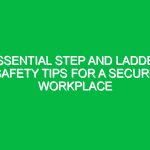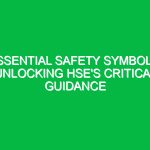Welcome to Today’s Toolbox Talk
Hello everyone! Thank you for gathering here today for our Toolbox Talk. Today, we’re focusing on a crucial aspect of Safety that affects each one of us: Seatbelt Use and Safety. Whether you’re driving a company vehicle, operating machinery, or riding as a passenger, proper seatbelt use is a fundamental practice that can prevent serious injuries or fatalities in case of an accident. Let’s dive into the essential tips, best practices, and Regulations surrounding seatbelt use to enhance our Workplace Safety culture.
Why Seatbelt Use Matters
Seatbelts are one of the simplest yet most effective safety devices in vehicles. According to the National Highway Traffic Safety Administration (NHTSA), seatbelts reduce the risk of death by 45% and the risk of serious injury by 50% for front-seat passengers. Every time we buckle up, we significantly increase our chances of returning home safely after work.
Now, let’s consider a real-life scenario. Imagine you’re driving a company truck and suddenly need to stop. Without a seatbelt, your body can be thrown forward, leading to severe injuries. Conversely, with your seatbelt fastened, you’ll remain securely in your seat, greatly reducing the risk of injury. This example highlights just how critical seatbelt use is in our daily operations.
Understanding the Risks
Neglecting to wear a seatbelt can have dire consequences. Here are some risks associated with improper seatbelt use:
- Increased Injury Severity: In the event of a collision, unbelted passengers can experience much greater trauma than those wearing seatbelts.
- Ejection from the Vehicle: In a crash, individuals not wearing a seatbelt are at a higher risk of being ejected from the vehicle, which often results in fatal injuries.
- Legal and Financial Consequences: Failing to wear a seatbelt can lead to fines and increased insurance premiums, not to mention potential liability in an accident.
Best Practices for Seatbelt Use and Safety
To ensure that we are all protected while on the road, let’s go over some Best Practices for seatbelt use:
1. Always Buckle Up
Make it a habit to buckle up before starting the engine. This applies to everyone in the vehicle—drivers and passengers alike. Remember, it’s not just personal safety; it’s about protecting your coworkers as well.
2. Adjust Your Seatbelt Properly
Ensure that the seatbelt fits snugly across your lap and shoulder. The lap belt should be low across your hips, and the shoulder belt should cross your chest and shoulder, away from your neck. An improperly positioned seatbelt can cause injuries in an accident.
3. Use the Right Equipment
For those operating heavy machinery or vehicles, ensure that the equipment is equipped with functional seatbelts. If you notice any issues, report them immediately. Never operate a vehicle or machinery without a working seatbelt.
4. Educate Others
As part of a safety-conscious culture, encourage your colleagues to wear their seatbelts. If you see someone not buckled up, kindly remind them of its importance. Sometimes, a gentle nudge is all it takes to save a life.
5. Lead by Example
As team members, we should all lead by example. Always wear your seatbelt, and display a commitment to safety. Your actions can influence others and foster a culture of safety within our team.
Regulations and Standards
It’s important to be aware of the regulations regarding seatbelt use. The Occupational Safety and Health Administration (OSHA) mandates that employers ensure their employees are safe from workplace Hazards, which includes adhering to transportation safety regulations. Here are a few key regulations to remember:
- State Laws: Many states have primary seatbelt laws, which means that officers can stop and ticket a driver solely for not wearing a seatbelt.
- Company Policies: Review our company’s safety policies, which may include mandatory seatbelt use and Training.
- HSE Guidelines: Regularly check that you are compliant with Health, Safety, and Environment (HSE) guidelines, ensuring that all Safety Measures are in place.
Real-Life Consequences of Not Wearing Seatbelts
Let’s take a moment to consider real-life consequences. In 2022, a tragic incident occurred involving a team member who was not wearing their seatbelt while traveling on company business. The vehicle was involved in a collision, resulting in severe injuries that could have been avoided had the individual been buckled up. This incident serves as a stark reminder of the importance of seatbelt use. It not only affects the individual but also impacts the entire team and organization.
Open Discussion: Your Experiences
Now, I’d like to open the floor for discussion. Have any of you experienced or witnessed situations where seatbelt use made a difference? Perhaps you have a story or an insight to share that could help us all understand the importance of this topic better.
Maintaining a Culture of Safety
As we wrap up today’s Toolbox Talk, let’s remember that safety is a shared responsibility. Each one of us plays a vital role in maintaining a safe working environment. By prioritizing seatbelt use and safety, we contribute to our overall well-being and that of our colleagues.
Conclusion: Key Takeaways
To summarize, here are the key points we discussed today:
- Always wear your seatbelt, regardless of your role or situation.
- Adjust your seatbelt properly to ensure maximum protection.
- Educate others and lead by example to foster a culture of safety.
- Be aware of and comply with relevant regulations and company policies.
Thank you all for your attention today and for your commitment to safety. Remember, every time you buckle up, you’re not just following a rule; you’re choosing to protect yourself and those around you. Let’s make seatbelt use a top priority in our daily operations! Stay safe out there!


